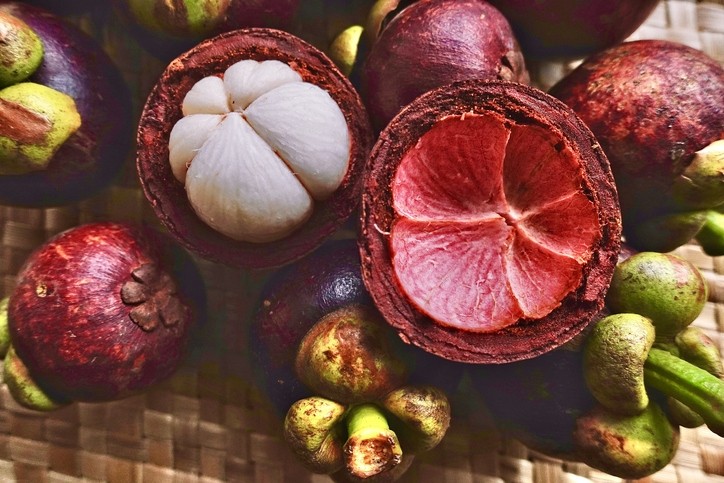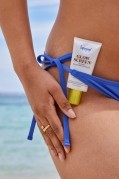Skin to skin: Potential benefits of upcycled mangosteen peel extract, study

The research team, Tan et al, was recently published in Cosmetics exploring the potential of mangosteen peels as a cosmetic ingredient, both because of its skincare properties, upcycling potential and impact on local economies.
Mangosteen is a sweet, juicy fruit cultivated mainly in Southeast Asia, particularly Malaysia. The fruit is often processed into juices, concentrates and dried fruits for consumption, leaving behind waste like peels.
Tan et al used mangosteen peels to create an upcycled, standardized extract with potential anti-aging, antioxidant, anti-wrinkle and pigmentation control effects.
“Natural antioxidants derived from natural sources such as mangosteen peel are preferable to synthetic antioxidants due to the undesirable side effects of synthetic antioxidants,” Tan et al said. “Hence, the objective of this study is to formulate and evaluate novel herbal face creams containing mangosteen peel extract that was standardized.”
Potential as active botanical
Antioxidant ingredients are commonly used to fight free radicals and mitigate their skin aging effects. Tan et al also said botanical ingredients may be preferable to synthetic ones to avoid adverse effects like skin dryness and irritation.
The research team found that their mangosteen peel extract had stronger antioxidant capacity compared to ascorbic acid, butylated hydroxytoluene and Trolox. Tan et al said, particularly compared to BHT’s possible skin irritation and pulmonary toxicity, mangosteen peel extract is relatively safe and effective.
According to the researchers, the antioxidant properties of mangosteen peel extract are likely attributable to phenolic compounds such as α-mangostin, flavonoids, epicatechins and tannins.
“Standardization is required to ensure the quality, safety, efficacy and reproducibility of mangosteen peel extract,” Tan et al said. “Furthermore, the organoleptic characteristics such as texture, greasiness and absorption are subjective and may vary from person to person.”
The extract was also able to inhibit the tyrosinase enzyme, which is involved in controlling the production of melanin. Tan et al found one form of the mangosteen peel extract reduced tyrosinase by more than 60%, meaning it could be an effective whitening ingredient.
Tan et al added that the origin, growth conditions, maturity, harvesting, processing and drying temperature may contribute to variation in phenolic compounds. They also said further studies should be conducted to evaluate the antioxidant, anti-aging and pigment-controlling effects.
Reduction of food production waste, support of local economies
Tan et al said the creation of cosmetics ingredients created from food waste, like mangosteen peels, is in line with sustainable development goals set forth by the United Nations to “reduce waste production and promote efficient use of natural resources and sustainable living.”
Like many upcycled ingredients, a standardized mangosteen peel extract could allow for a circular economy approach, particularly in the regions which produce the plant’s food products.
Malaysia is one of the leading producers of mangosteen fruit and the crop was specifically mentioned in the country’s 2006-2010 development plan as an important domestic and exported product.
“The development of green cosmeceutical mangosteen herbal face cream helps to boost the local economy and increase the chance of international collaboration,” Tan et al said.
Source: Cosmetics
Author: Puay L. Tan et al
Cosmetics 2022, 9(3), 46; https://doi.org/10.3390/cosmetics9030046
Title: Formulation and Physicochemical Evaluation of Green Cosmeceutical Herbal Face Cream Containing Standardized Mangosteen Peel Extract
![Vitamin C or ascorbic acid offers many skin health benefits when incorporated into topical formulations, from UV damage protection to collagen maintenance [Getty Images]](/var/wrbm_gb_food_pharma/storage/images/_aliases/wrbm_medium/publications/cosmetics/cosmeticsdesign-europe.com/article/2023/01/17/vitamin-c-in-topical-cosmetics-promising-for-skin-health-says-review/16092233-1-eng-GB/Vitamin-C-in-topical-cosmetics-promising-for-skin-health-says-review.jpg)
![The European dairy industry produces around 75 million tonnes of whey each year and the cheese sector is considered the 'most polluting' [Getty Images]](/var/wrbm_gb_food_pharma/storage/images/_aliases/wrbm_medium/publications/cosmetics/cosmeticsdesign-europe.com/article/2022/12/02/ingreen-eu-project-identifies-cheese-whey-as-having-cosmetic-active-ingredient-promise-says-ineuvo-ltd/15991835-1-eng-GB/INGREEN-EU-project-identifies-cheese-whey-as-having-cosmetic-active-ingredient-promise-says-Ineuvo-Ltd.jpg)
![Phytocosmetics offer plenty of promise due to the antioxidant content within many plants, but extraction and delivery systems need more focus [Getty Images]](/var/wrbm_gb_food_pharma/storage/images/_aliases/wrbm_medium/publications/cosmetics/cosmeticsdesign-europe.com/article/2022/07/19/plant-based-beauty-phytocosmetics-promise-with-extraction-delivery-and-certification-advances/15611273-1-eng-GB/Plant-based-beauty-phytocosmetics-promise-with-extraction-delivery-and-certification-advances.jpg)
![Several herbal extracts are documented as offering protective or healing properties around UV exposure, including rosemary, lemon balm and grapefruit [Getty Images]](/var/wrbm_gb_food_pharma/storage/images/_aliases/wrbm_medium/publications/cosmetics/cosmeticsdesign-europe.com/headlines/formulation-science/herbal-extracts-sunscreen-and-uv-skin-damage-promise-finds-review/15406249-1-eng-GB/Herbal-extracts-sunscreen-and-UV-skin-damage-promise-finds-review.jpg)
















